
94% of researchers rate our articles as excellent or good
Learn more about the work of our research integrity team to safeguard the quality of each article we publish.
Find out more
ORIGINAL RESEARCH article
Front. Phys., 26 November 2020
Sec. Statistical and Computational Physics
Volume 8 - 2020 | https://doi.org/10.3389/fphy.2020.602229
This article is part of the Research TopicPeregrine Soliton and Breathers in Wave Physics: Achievements and PerspectivesView all 25 articles
In this theoretical investigation, we have examined the combined effects of nonthermally revamped polarization force on modulational instability MI of dust acoustic waves DAWs and evolution of different kinds of dust acoustic (DA) breathers in a dusty plasma consisting of negatively charged dust as fluid, Maxwellian electrons, and ions obeying Cairns’ nonthermal distribution. The nonthermality of ions has considerably altered the strength of polarization force. By employing the multiple-scale perturbation technique, the nonlinear Schrödinger equation NLSE is derived to study modulational MI instability of dust acoustic waves DAWs. It is noticed that influence of the polarization force makes the wave number domain narrow where MI sets in. The rational solutions of nonlinear Schrödinger equation illustrate the evolution of DA breathers, namely, Akhmediev breather, Kuznetsov–Ma breather, and Peregrine solitons (rogue waves). Further, the formation of super rogue waves due to nonlinear superposition of DA triplets rogue waves is also discussed. It is analyzed that combined effects of variation in the polarization force and nonthermality of ions have a comprehensive influence on the evolution of different kinds of DA breathers. It is remarked that outcome of present theoretical investigation may provide physical insight into understanding the role of nonlinear phenomena for the generation of various types of DA breathers in experiments and different regions of space (e.g., the planetary spoke and cometary tails).
The plasma physicists have rejuvenated the research in the dusty plasma after the confirmation of presence of dust grains in Saturnian rings by Cassini and Voyager space missions [1]. It has been remarkably reported that such kind of dusty plasma is extremely abundant in various space/astrophysical environments (e.g., solar nebulae and comet tails) [2–6] and laboratory (e.g., manufacturing and processing of semiconductor devices) [7, 8]. The characteristic features of different nonlinear wave excitations in various space dusty plasma environments have been explored by numerous researchers. Prolific literature has confirmed the existence of extremely massive (i.e., nearly
Over the last few decades, the study of modulational instability and evolution of nonlinear envelope solitons in the context of nonlinear Schrödinger equation (NLSE) becomes an intriguing area of research in different plasma systems. The rational solutions of NLSE describe broad range of spatially and temporally localized sets of soliton solutions. One of such rational solutions is called Peregrine soliton [28] or prototype of the rogue waves resulting from counterbalance between nonlinearity and group velocity dispersion. The investigation of rogue waves has enhanced comprehensive understanding of evolution and formation of these mysterious waves in the ocean [29, 30]. It is demonstrated that the Peregrine breather plays a pivotal role for exclusive study of rogue waves [31]. It is reported that rogue waves are usually singular and large amplitude waves with draconian effects on living creatures. The rogue waves are known for their sudden appearance as a deep hole and huge crest in a serial pattern. Rogue waves have extremely large amplitude waves that evolve suddenly and then collapse without clue. Such kinds of waves are also observed in nonlinear optics, superfluids, and Bose–Einstein condensates [32, 33]. Further, it is also illustrated that the breather solutions of NLSE can be categorized as Kuznetsov–Ma breathers (space localized patterns and periodic in time) [34, 35] and the second class of breathers is the Akhmediev breather (which is periodic in space and localized in time) [36]. An experimental investigation of the formation of Peregrine solitons was reported by Bailung et al. [37] in a multicomponent plasma composed of negative ions. They illustrated that wave becomes modulationally unstable for critical value of negative ions density. Pathak et al. [38] have experimentally illustrated the occurrence of higher-order Peregrine breathers with amplitude five times the background carrier wave in multispecies plasma and verified their findings with second-order rational solution of breathers obtained from NLSE. Numerous researchers [39, 40] have also studied the evolutionary dynamics of such kind of nonlinear coherent solutions in different plasma environments. The nonlinear superposition of first-order rogue waves yields a complex and localized nonlinear structure with excessively large amplitude known as higher-order rogue waves and becomes a fascinating area of research. Such kind of pecking-order of higher-order breather solutions with a huge amplitude is called SRWs. Moreover, the rogue waves are first-order rational solution while SRWs are higher-order solution of NLSE. The nonlinear superposition of these TRWs forms the SRWs. The amplitude of SRWs goes on rising as triplets are replaced by sextets and so on [41, 42]. The observation of these higher- (second-) order rogue waves (RWs) has been verified in laboratory experiment including theoretical investigation [37, 38]. Numerous investigations of dust acoustic rogue waves have been reported in different plasma environments [43–50]. Singh and Saini [49] have observed that polarization force controls the MI domain of DA waves in a superthermal dusty plasma. They have also illustrated the evolutionary transition of DARW triplets to SRWs in a space dusty plasma. Recently, Jahan et al. [50] have studied the MI and DA rogue waves in a four-component dusty plasma having inertial two fluids of heavy as well as light negatively charged dust grains, superthermal electrons, and nonthermal ions. It is remarked that the conditions for the existence of DARWs are strongly altered under the influence of nonthermality of ions and superthermality of electrons.
Various satellite observations have disseminated the prevalence and abundance of energetic charged particles that exhibit nonthermal tails in the planetary magnetospheres and solar wind [51, 52]. Cairns et al. [53] introduced a new kind of distribution referred to as Cairns distribution in order to explore the concept of negative potential electrostatic wave structures observed by the Freja satellite [54]. They illustrated that the occurrence of charged particles obeying nonthermal distribution can appreciably change the propagation properties of ion acoustic waves in conformity with observations of Freja [54] and Viking [55] satellites. Nonthermal charged particles have been found in the Earth’s bow-shock [56], Mar’s ionosphere [57], lunar vicinity [58], and the Jupiter and Saturn environments [59]. A large number of studies have focused on the characteristics of different nonlinear waves in the framework of nonthermal Cairns distribution in various plasma systems [27, 60–62]. Singh [60] studied the propagation of ion acoustic waves (IAWs) in an inhomogeneous electron-ion plasma having nonthermal electrons obeying Cairns distribution. The characteristics of nonlinear IAWs are strongly affected by the density inhomogeneities as well as nonthermality of electrons. Kalita and Kalita [61] studied the dust acoustic waves in a dusty plasma composed of weakly relativistic electrons, nonthermal ions (obeying Cairns distribution), and negatively charged dust. They found that the variation in nonthermal parameter of ions significantly modifies the amplitude of both compressive and rarefactive solitons. Shan et al. [62] studied the influence of nonthermality of electrons as well as protons on the formation of electrostatic ion acoustic waves in an ionospheric plasma.
In our present investigation, we have explored the MI of DAWs and hierarchy of DA breathers, Peregrine solitons, TRWs, and SRWs in a nonthermally polarized space dusty plasma having Cairns distributed nonthermal ions, Maxwellian electrons, and negatively charged dust fluid. Our present optimum knowledge authenticates that no such type of investigation has been carried out yet. We have used multiple-scale perturbation technique to obtain NLSE to study the MI and from its solution, the full class of
In this present investigation, we have examined the influence of polarization force and nonthermality of ions, on the evolution of dust acoustic rogue waves, breathers, and Peregrine solitons in a polarized space dusty plasma having negative dust fluid, Boltzmann electrons, and ions obeying Cairns nonthermal distribution. The modified expression for polarization force under the effect of nonthermal ions can be written as [27]
where
The normalized expression for number density of nonthermally distributed ions by using Taylor’s expansion can be written as [27]
where α is the spectral index of nonthermally distributed ions. For low effect of nonthermality of ions, α is small. We have considered the normalized number density of electrons which is given as
The nonthermally modified polarization force term is used in the dust momentum equation to examine the role of polarization force and nonthermality of ions on
and
where
To analyze the characteristics of modulated DAWs in nonthermally polarized space dusty plasma, NLSE is derived from Eqs 3–5 by employing expansion of dependent state variables and following stretching coordinates:
where finite parameter
where
By putting Eqs 6 and 7 into Eqs 3–5 and equating terms of first-order
Further, we obtain
where
Equation 10 represents the group velocity of the
From the expressions corresponding to third harmonics
where P and Q are dispersion and nonlinear coefficients, respectively. Expressions for these coefficients and other steps involved in the derivation of NLSE are illustrated in Appendix.
In this section, we have performed numerical analysis to examine the MI of DAWs and dynamics of DA breathers, Peregrine solitons, and evolution of DA-TRWs to SRWs in a nonthermal polarized dusty plasma. For numerical analysis, we have used MATHEMATICA-10 based program. We have discussed the combined influence of different plasma parameters (e.g.,
We ensure that Eq. 11 represents a plane wave solution
It is noted that when the ratio of P to Q is positive (i.e.,
It is observed that MI gets stabilized by developing a train of envelope in the form of bright solitons. When the ratio of P to Q is negative (i.e.,
The stability profile of DAWs is examined in Figure 1A which illustrates the variation of critical wave number
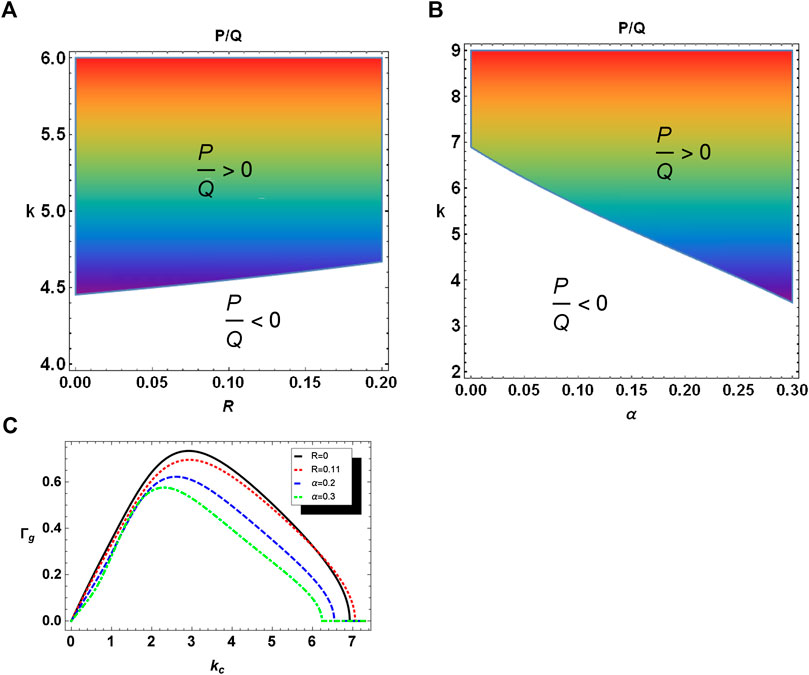
FIGURE 1. The contour plot of
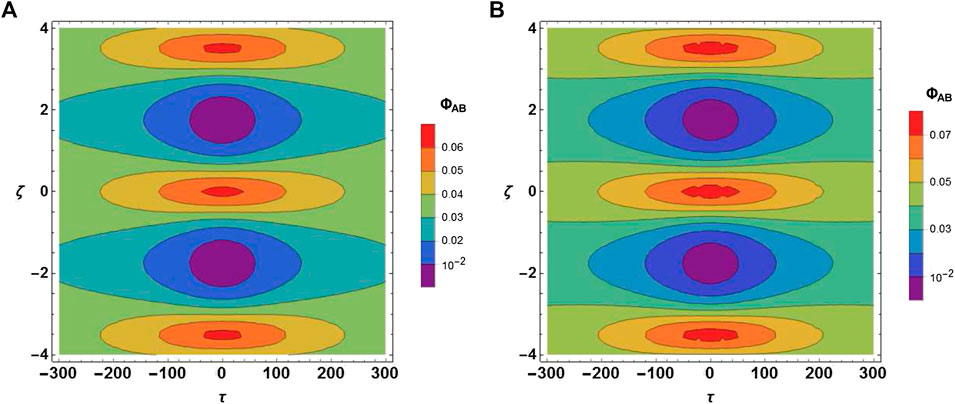
FIGURE 3. The variation of DA Akhmediev breathers profile in ζ-τ plane (A) for
Now, the main focus of our investigation is to analyze solutions for
The Peregrine structure [28] as a prototype model for rogue waves has been adopted as a single rogue profile whose amplitude reduces in both time and space. The Peregrine solitons have been examined experimentally in water wave tank [40] and also in plasma [37] situations. The NLS Eq. 11 provides a first-order rational solution confined in both τ and ζ-plane given by
Here, we have presented the standard solution of Peregrine solitons (i.e., rogue waves). In the limiting case, when both
Figure 2A depicts the absolute of amplitude profile of DARWs for distinct values of polarization parameter R. It is seen that rise in R leads to escalating the amplitude of DARWs, whereas Figure 2B shows that increase in α (i.e., nonthermality of ions) reduces the amplitude of DARWs. Consequently, the polarization parameter increases the nonlinearity which leads to enhancing the amplitude of DARWs whereas nonlinearity decreases with the increase in nonthermality of ions and hence amplitude enervates.

FIGURE 2. The variation of DARW portrait with respect to ζ (A) for different values of R and (B) for different values of α at fixed values of
The Akhmediev breather [36] is an exact solution of the NLSE Eq. 11 which illustrates the MI regime. The associated waveforms (periodic in space and confined in time) are given by
Here, free parameter “
Figures 3A,B illustrate the variation of DA-AB for distinct values of polarization parameter (via R). It is observed that amplitude of DA-AB escalates with rise in polarization parameter. Figures 4A,B show the variation of DA Akhmediev breather for distinct values of nonthermality parameter (via α). It is found that amplitude of DA-AB reduces with rise in nonthermality of ions.
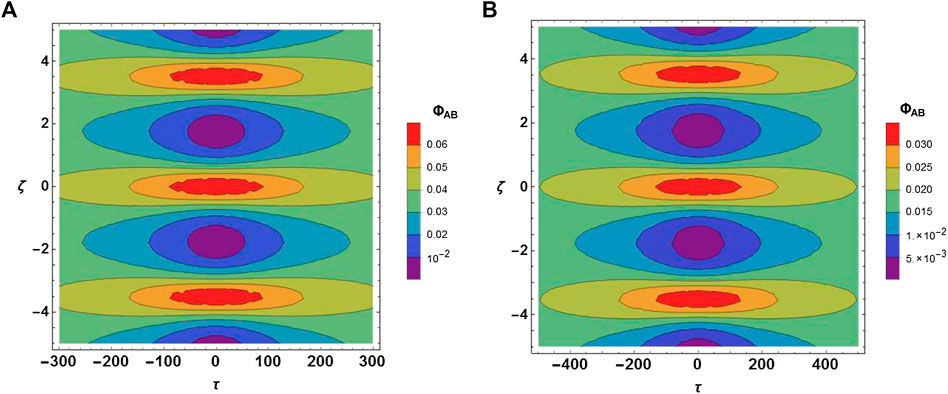
FIGURE 4. The variation of DA Akhmediev breathers profile in ζ-τ plane (A) for
Kuznetsov [34] and Ma [35] introduced one of the breather solutions which is named Kuznetsov–Ma (KM) breather. On the contrary to the AB, KM breather is periodic in time and confined in space and is given by [34, 35]
Here,
Figures 5A,B depict the variation in DA-KM breather for distinct values of polarization parameter (via R). It is observed that amplitude of DA-KM breather increases with increase in polarization parameter. Figures 6A,B show the variation in DA-KM breather for distinct values of nonthermal parameter (via α). It is found that the absolute amplitude of DA-KM breather decreases with rise in nonthermality of ions.
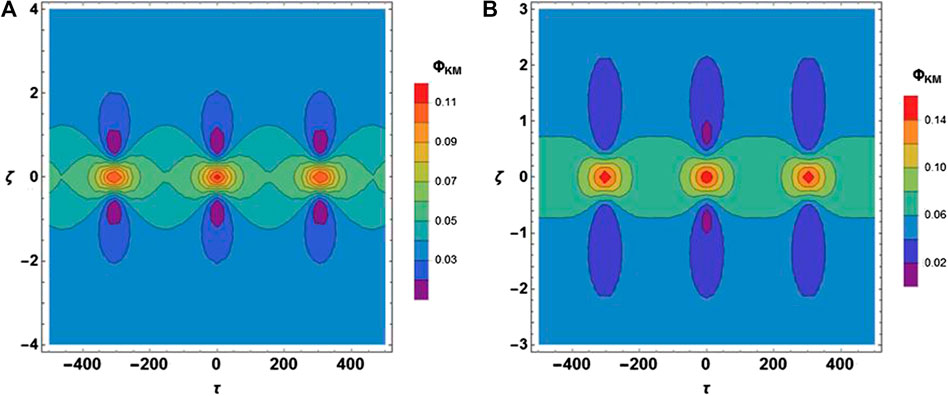
FIGURE 5. The variation of DA Kuznetsov–Ma breather profile in ζ - τ plane (A) for

FIGURE 6. The variation of DA Kuznetsov–Ma breather profile in ζ - τ plane (A) for
The maximum amplitude of breathers can be recapitulated as
Figures 7A–C illustrate the evolution of DA-AB, DA-KM breather, and DARWS for different
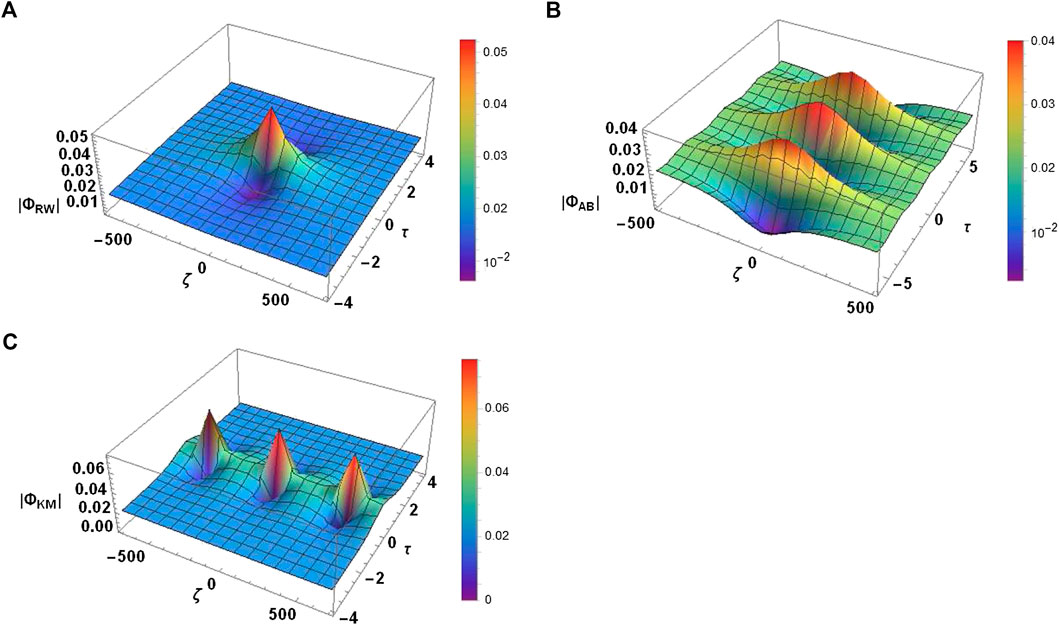
FIGURE 7. The 3D profile of (A) DA rogue waves at
Over the last many years, the rogue wave triplets and super RWs solutions of NLSE have been studied theoretically as well as experimentally by numerous researchers [38, 41, 42]. It is found that rogue wave triplets are second-order RWs, and the nonlinear superposition of these DA-TRWs can give birth to higher amplitude SRWs that are also confined in both time and space domains. The higher-order rational solution of Eq. 11 recognizes the DA-TRWs solution for unstable regime [41]:
where
Here,
Figures 8A,B display the influence of absolute of the amplitude of DA-TRWs for distinct values of polarization force (R). An increase in R produces enhancement in the amplitude of DA-TRWs. Figures 9A,B demonstrate the absolute of the DA-TRWs profile for distinct values of α. It is remarked that with an increment in α (i.e., nonthermality of ions) the absolute amplitude DA-TRWs is enervated. The nonlinearity decreases as the nonthermality of ions increases and consequently, the amplitude of DA-TRWs gets reduced. To demonstrate the evolutionary of DA-SRWs in space dusty plasma, we choose

FIGURE 10. The variation of DA-SRWs portrait vs. ζ (A) for different values of R and (B) for different values of α whereas
We have numerically studied the evolution of different kinds of DA breathers, Peregrine solitons, rogue wave triplets, and super rogue waves in a dusty plasma containing negatively charged dust fluid, Maxwellian electrons, and nonthermal ions (obeying Cairns distribution) in the presence of polarization force. First, the role of nonthermality of ions on the polarization force is discussed. By applying the multiple-scale perturbation technique, the NLSE is derived to analyze the MI of the DAWs. It is conspicuous that the polarization parameter controls the wave number domain whereas nonthermality of ions broadens the instability regime. The evolution of dust acoustic AB, KM breather, Peregrine solitons, DA-TRWs, and higher-order SRWs has been illustrated under the impact of nonthermal polarization force. Furthermore, an epoch-making role of all physical parameters like nonthermality of ions and polarization force on the characteristics of dust acoustic AB, KM breather, and first- as well as second-order RWs has been studied. The paramount findings of this study might provide the physical insight of nonlinear coherent structures in planetary rings where nonthermal ions are prevalent in different space environments. We propose to perform a dusty plasma experiment to validate our theoretical predications as formation of IA freak waves has already been examined experimentally by the researchers [37, 38].
The original contributions presented in the study are included in the article; further inquiries can be directed to the corresponding authors.
All authors have contributed equally.
The authors declare that the research was conducted in the absence of any commercial or financial relationships that could be construed as a potential conflict of interest.
From second harmonics
Further, the second harmonics
These self-interactions provide the zeroth-order harmonics which can be analytically obtained by collecting
Equating the third harmonics
Now, substituting Eqs 8, A2, and A3 along with Eq. A1 in Eqs A4–A6, we get
Now, eliminating the
The expressions for dispersion coefficient (P) and nonlinear coefficient (Q) are given as
The authors acknowledge the support by DRS-II (SAP) No. F 530/17/DRS-II/2015(SAP-I) UGC and DST-PURSE.
1. Goertz CK. Dusty plasmas in the solar system. Rev Geophys (1989). 27:271–92. doi:10.1029/rg027i002p00271.
2. Horanyi M, Mendis DA. The effects of electrostatic charging on the dust distribution at Halley's Comet. Astrophys J (1986). 307:800–7. doi:10.1086/164466.
4. Mendis DA, Rosenberg M. Cosmic dusty plasma. Annu Rev Astron Astrophys (1994). 32:419–63. doi:10.1146/annurev.aa.32.090194.002223.
5. Thomas H, Morfill GE, Demmel V, Goree J, Feuerbacher B, Möhlmann D. Plasma crystal: coulomb crystallization in a dusty plasma. Phys Rev Lett (1994). 73:652–55. doi:10.1103/physrevlett.73.652.
6. Bouchoule A, Plain A, PH-Blondeau L, Laure C. Particle generation and behavior in a silane‐argon low‐pressure discharge under continuous or pulsed radio‐frequency excitation. J Appl Phys (1991). 70:1991–2000. doi:10.1063/1.349484.
7. Laure AA, James BW, Vladimirov SV, Cramer NF. Self-excited vertical oscillations in an rf-discharge dusty plasma. Phys Rev E (2001). 64:025402. doi:10.1103/physreve.64.025402.
8. Adhikary NC, Bailung H, Pal AR, Chutia J, Nakamura Y. Observation of sheath modification in laboratory dusty plasma. Phys Plasmas (2007). 14:103705. doi:10.1063/1.2798046.
9. Mamun AA, Shukla PK. Electrostatic solitary and shock structures in dusty plasmas. Phys Scripta (2002). T98:107–14.
10. Shukla PK. Nonlinear waves and structures in dusty plasmas. Phys Plasmas (2003). 10:1619–27. doi:10.1063/1.1557071.
11. Shukla PK, Mamum AA. Introduction to dusty plasma physics Bristol, England: Institute of Physics Publishing (2002).
12. Shukla PK, Silin VP. Dust ion-acoustic wave. Phys Scripta (1992). 45:508. doi:10.1088/0031-8949/45/5/015.
13. Rao NN, Shukla PK, Yu MY. Dust-acoustic waves in dusty plasmas. Planet Space Sci (1990). 38:543–6. doi:10.1016/0032-0633(90)90147-i.
14. Amin MR, Morfill GE, Shukla PK. Modulational instability of dust-acoustic and dust-ion-acoustic waves. Phys Rev E (1998). 58:6517–23. doi:10.1103/physreve.58.6517.
16. Shukla PK, Bharuthram R, Schlickeiser R. Instability of the Shukla mode in a dusty plasma containing equilibrium density and magnetic field inhomogeneities. Phys Plasmas (2004). 11:1732. doi:10.1063/1.1668643.
17. El-Labany SK, El-Bedwehy NA, Selim MM, Al-Abbasy OM. Effect of dust-charge fluctuations on dust acoustic solitary waves in an inhomogeneous dusty plasma with nonextensive electrons. Phys Plasmas (2015). 22:023711. doi:10.1063/1.4913649.
18. El-Taibany WF, Sabry R. Dust-acoustic solitary waves and double layers in a magnetized dusty plasma with nonthermal ions and dust charge variation. Phys Plasmas (2005). 12:082302. doi:10.1063/1.1985987.
19. Hamaguchi S, Farouki RT, Hamaguchi S, Farouki RT. Polarization force on a charged particulate in a nonuniform plasma. Phys Rev E (1994). 49:4430–4441. doi:10.1103/physreve.49.4430.
20. Khrapak SA, Ivlev AV, Yaroshenko VV, Morfill GE. Influence of a polarization force on dust acoustic waves. Phys Rev Lett (2009). 102:245004. doi:10.1103/physrevlett.102.245004.
21. Bandyopadhyay P, Prasad G, Sen A, Kaw PK. Experimental study of nonlinear dust acoustic solitary waves in a dusty plasma. Phys Rev Lett (2008). 101:065006. doi:10.1103/physrevlett.101.065006.
22. Bandyopadhyay P, Konopka U, Khrapak SA, Morfill GE, Sen A. Effect of polarization force on the propagation of dust acoustic solitary waves. New J Phys (2010). 12:073002. doi:10.1088/1367-2630/12/7/073002.
23. Mamun AA, Ashrafi KS, Shukla PK. Effects of polarization force and effective dust temperature on dust-acoustic solitary and shock waves in a strongly coupled dusty plasma. Phys Rev E (2010). 82:026405. doi:10.1103/physreve.82.026405.
24. Ashrafi KS, Mamun AA, Shukla PK. Time-dependent cylindrical and spherical dust-acoustic solitary and shock waves in a strongly coupled dusty plasma in the presence of polarization force. Europhys Lett (2010). 92:15004. doi:10.1209/0295-5075/92/15004.
25. Asaduzzaman M, Mamun AA, Ashrafi KS. Dust-acoustic waves in nonuniform dusty plasma in presence of polarization force. Phys Plasmas (2011). 18:113704. doi:10.1063/1.3657432.
26. Singh K, Ghai Y, Kaur N, Saini NS. Effect of polarization force on dust acoustic cnoidal waves in dusty plasma. Euro Phys J D (2018). 72:160. doi:10.1140/epjd/e2018-90228-2.
27. Singh K, Sethi P, Saini NS. Effect of polarization force on head-on collision between multi-solitons in dusty plasma. Phys Plasmas (2018). 25:033705. doi:10.1063/1.5020194.
28. Peregrine DH. Water waves, nonlinear Schrödinger equations and their solutions. J Aust Math Soc Ser B Appl Math (1983). 25:16. doi:10.1017/s0334270000003891.
30. Osborne AR. Nonlinear ocean waves and the inverse scattering transform Amsterdam: Elsevier (2010).
31. Akhmediev N, Ankiewicz A, Taki M. Waves that appear from nowhere and disappear without a trace. Phys Lett A (2009). 373:675–8. doi:10.1016/j.physleta.2008.12.036.
33. Müller P, Garrett C, Osborne A. Meeting report|rogue waves-the fourteenth 'Aha Huliko'a Hawaiian winter workshop. Oceanog (2005). 18:66–75. doi:10.5670/oceanog.2005.30.
35. Ma Y-C. The perturbed plane-wave solutions of the cubic Schrödinger equation. Stud Appl Math (1979). 60:43. doi:10.1002/sapm197960143.
36. Akhmediev NN, Eleonskii VM, Kulagin NE. Exact first-order solutions of the nonlinear Schrödinger equation. Theor Math Phys (1987). 72:809–18. doi:10.1007/bf01017105.
37. Bailung H, Sharma SK, Nakamura Y. Observation of Peregrine solitons in a multicomponent plasma with negative ions. Phys Rev Lett (2011). 107:255005. doi:10.1103/physrevlett.107.255005.
38. Pathak P, Sharma SK, Nakamura Y, Bailung H. Observation of second order ion acoustic Peregrine breather in multicomponent plasma with negative ions. Phys Plasmas (2016). 23:022107. doi:10.1063/1.4941968.
39. Ankiewicz A, Kedziora DJ, Akhmediev N. Rogue wave triplets. Phys Lett A (2011). 375:2782–5. doi:10.1016/j.physleta.2011.05.047.
40. Chabchoub A, Hoffmann N, Onorato M, Akhmediev N. Super rogue waves: observation of a higher order breather in water waves. Phys Rev X (2012). 2:011015. doi:10.1103/physrevx.2.011015.
41. Guo S, Mei L, Shi W. Rogue wave triplets in an ion-beam dusty plasma with superthermal electrons and negative ions. Phys Lett A (2013). 377:2118–25. doi:10.1016/j.physleta.2013.06.015.
42. Guo S, Mei L, He Y, Li Y. Modulation instability and ion-acoustic rogue waves in a strongly coupled collisional plasma with nonthermal nonextensive electrons. Plasma Phys Contr Fusion (2016). 58:025014. doi:10.1088/0741-3335/58/2/025014.
43. Moslem WM, Sabry R, El-Labany SK, Shukla PK. Dust acoustic rogue waves in a nonextensive plasma. Phys Rev (2011). 84:066402. doi:10.1103/physreve.84.066402.
44. Zaghbeer SK, Salah HH, Sheta NH, El-Shewy EK, Elgarayh A. Effect of nonextensive electron and ion on dust acoustic rogue waves in dusty plasma of opposite polarity. Astrophys Space Sci (2014). 353:493. doi:10.1007/s10509-014-2081-x.
45. Bouzit O, Tribeche M. Dust-acoustic waves modulational instability and rogue waves in a polarized dusty plasma Phys Plasmasdoi:10.1063/1.4933006.
46. Singh K, Kaur N, Saini NS. Head-on collision between two dust acoustic solitary waves and study of rogue waves in multicomponent dusty plasma. Phys Plasmas (2017). 24:063703. doi:10.1063/1.4984996.
47. Kaur N, Singh K, Ghai Y, Saini NS. Nonplanar dust acoustic solitary and rogue waves in an ion beam plasma with superthermal electrons and ions. Plasma Sci Technol (2018). 20:074009. doi:10.1088/2058-6272/aac37a.
48. Shikha RK, Chowdhury NA, Mannan A, Mamun AA. Dust acoustic rogue waves in an electron depleted plasma. Eur Phys J D (2019). 73:177. doi:10.1140/epjd/e2019-100158-8.
49. Singh K, Saini NS. The evolution of rogue wave triplets and super rogue waves in superthermal polarized space dusty plasma. Phys Plasmas (2019). 26:113702. doi:10.1063/1.5119894.
50. Jahan S, Mannan A, Chowdhury NA, Mamun AA. Dust-acoustic rogue waves in four-component plasmas. Plasma Phys Rep (2020). 46:90–6. doi:10.1134/s1063780x20010110.
51. Christon SP, Mitchell DG, Williams DJ, Frank LA, Huang CY, Eastman TE. Energy spectra of plasma sheet ions and electrons from ∼50 eV/eto ∼1 MeV during plasma temperature transitions. J Geophys Res (1988). 93:2562. doi:10.1029/JA093iA04p02562.
52. Pierrard V, Lamy H, Lemaire J. Exospheric distributions of minor ions in the solar wind. J Geophys Res (2004). 109:A02118. doi:10.1029/2003JA010069.
53. Cairns RA, Mamum AA, Bingham R, Boström R, Dendy RO, Nairn CMC, et al. . Electrostatic solitary structures in non-thermal plasmas. Geophys Res Lett (1995). 22:2709. doi:10.1029/95GL02781.
54. Bostrom R. Observations of weak double layers on auroral field lines. IEEE Trans Plasma Sci (1992). 20:756. doi:10.1109/27.199524.
55. Dovner PO, Eriksson AI, Boström R, Holback B. Freja Multiprobe observations of electrostatic solitary structures. Geophys Res Lett (1994). 21:1827–30. doi:10.1029/94GL00886.
56. Asbridge JR, Bame SJ, Strong IB. Outward flow of protons from the Earth's bow shock. J Geophys Res (1968). 73:5777. doi:10.1029/JA073i017p05777.
57. Lundlin R, Zakharov A, Pellinen R, Borg H, Hultqvist B, Pissarenko N, et al. . First measurements of the ionospheric plasma escape from Mars. Nature (London) (1989). 341:609–12.
58. Futaana Y., Machida S, Saito Y, Matsuoka A, Hayakawa H. Moon-related nonthermal ions observed by Nozomi: species, sources, and generation mechanisms. J Geophys Res (2003). 108:1025. doi:10.1029/2002JA009366.
59. Krimigis SM, Carbary JF, Keath EP, Armstrong TP, Lanzerotti LJ, Gloeckler G. General characteristics of hot plasma and energetic particles in the saturnian magnetosphere: results from the voyager spacecraft. J Geophys Res (1983). 88:8871. doi:10.1029/JA088iA11p08871.
60. Singh SV. Nonlinear ion acoustic waves in an inhomogeneous plasma with non-thermal distribution of electrons. J Plasma Phys (2015). 81:905810315. doi:10.1017/s0022377815000094.
61. Kalita BC, Kalita R. Implicit role of Cairns distributed ions and weak relativistic effects of electrons in the formation of dust acoustic waves in plasma. J Plasma Phys (2016). 82:905820201. doi:10.1017/s0022377816000167.
62. Shan SA, Hassan I, Saleem H. Electrostatic wave instability and soliton formation with non-thermal electrons in O–H plasma of ionosphere. Phys Plasmas (2019). 26:022114. doi:10.1063/1.5079841.
63. Saini NS, Kourakis I. 000Dust-acoustic wave modulation in the presence of superthermal ions. Phys Plasmas (2008). 15:123701. doi:10.1063/1.3033748.
64. Misra AP, Roy Chowdhury A. Modulational instability of dust acoustic waves in a dusty plasma with nonthermal electrons and ions. Eur Phys J D (2006). 39:49. doi:10.1140/epjd/e2006-00079-1.
Keywords: dust acoustic waves, breather wave, Peregrine soliton, polarization force, rogue wave, Cairns nonthermal distribution
Citation: Singh K and Saini NS (2020) Breather Structures and Peregrine Solitons in a Polarized Space Dusty Plasma. Front. Phys. 8:602229. doi: 10.3389/fphy.2020.602229
Received: 02 September 2020; Accepted: 05 October 2020;
Published: 26 November 2020.
Edited by:
Bertrand Kibler, UMR6303 Laboratoire Interdisciplinaire Carnot de Bourgogne (ICB), FranceReviewed by:
R. Sabry, Prince Sattam Bin Abdulaziz University, Saudi ArabiaCopyright © Singh and Saini. This is an open-access article distributed under the terms of the Creative Commons Attribution License (CC BY). The use, distribution or reproduction in other forums is permitted, provided the original author(s) and the copyright owner(s) are credited and that the original publication in this journal is cited, in accordance with accepted academic practice. No use, distribution or reproduction is permitted which does not comply with these terms.
*Correspondence: N. S. Saini, bnNzYWluaS5waHlAZ25kdS5hYy5pbjtuc3NhaW5pQHlhaG9vLmNvbQ==; Kuldeep Singh, c2luZ2gua2RlZXAwN0BnbWFpbC5jb20=
Disclaimer: All claims expressed in this article are solely those of the authors and do not necessarily represent those of their affiliated organizations, or those of the publisher, the editors and the reviewers. Any product that may be evaluated in this article or claim that may be made by its manufacturer is not guaranteed or endorsed by the publisher.
Research integrity at Frontiers

Learn more about the work of our research integrity team to safeguard the quality of each article we publish.